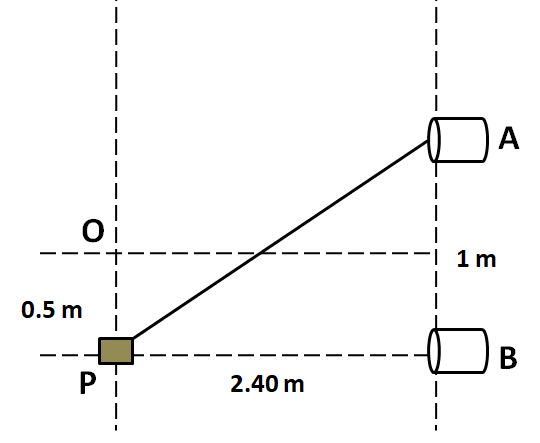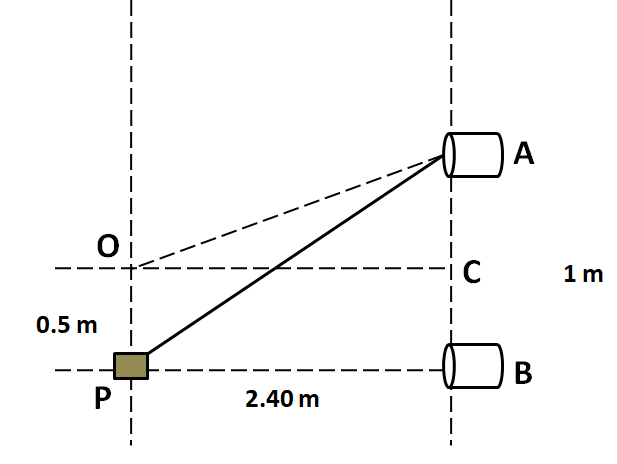
Two speakers A and B are placed $1m$ apart, each produces sound waves of frequency $1800Hz$ in phase. A detector moving parallel to the line joining the speakers at a distance of $2.4m$ away detects a maximum intensity at O and then at P. Speed of the sound wave is:

(A) $330m{s^{ - 1}}$
(B) $360m{s^{ - 1}}$
(C) $350m{s^{ - 1}}$
(D) $340m{s^{ - 1}}$
Answer
218.7k+ views
Hint: To solve this question, we have to find out the path difference at the two points O and P. Then applying the conditions of the maxima at these points, we can get the wavelength of the sound. The frequency is already given in the question, and from the relation between the frequency and the wavelength, the velocity of the sound wave can be found out.
Formula used: The formula used to solve this question is given by
$\lambda = \dfrac{v}{f}$, here $\lambda $ is the wavelength, $v$ is the velocity, and $f$ is the frequency of a wave.
Complete step-by-step answer:
Let the speed of the sound wave be $v$.
The frequency of the sound wave produces by each of the sources is given to be $1800Hz$, that is,
$f = 1800Hz$
We know that the wavelength is given by
$\lambda = \dfrac{v}{f}$
So the wavelength of the sound produced by each source is
$\lambda = \dfrac{v}{{1800}}$ ……………...(1)
Now, let us label the midpoint of the line AB joining the two sources as C, which is shown in the below figure.

In the triangle AOC, by the Pythagoras theorem we get
$O{C^2} + A{C^2} = O{A^2}$
$ \Rightarrow {2.4^2} + {0.5^2} = O{A^2}$
On solving we get
$OA = 2.45m$
Similarly, we have $OB = 2.45m$
The path difference at O is
$PD = OA - OB$
$PD = 2.6 - 2.6 = 0$
So the path difference at O is equal to zero.
Hence, there will be central maxima at O.
According to the question, the next maxima occurs at P. Therefore, there occurs the first maxima at P.
So the path difference at P must be
$PD' = 1\lambda = \lambda $ ………………..(2)
In the triangle APB, applying Pythagoras theorem
$A{B^2} + B{P^2} = A{P^2}$
From the above figure, $BP = 2.4m$ and $AB = 1m$. Substituting these above we get
${1^2} + {2.4^2} = A{P^2}$
On solving we get
$AP = 2.6m$
Also, from the above figure, we have $BP = 2.4m$.
So the path difference at P is given by
$PD' = AP - BP$
$ \Rightarrow PD' = 2.6 - 2.4$
On solving
$PD' = 0.2m$ ………………….(3)
From (2) and (3)
$\lambda = 0.2m$
From (1)
$\dfrac{v}{{1800}} = 0.2$
$ \Rightarrow v = 360m{s^{ - 1}}$
Thus, the velocity of the sound wave is equal to $360m{s^{ - 1}}$.
Hence, the correct answer is option B.
Note: We should not get confused in the indexing of the maximas. Although the central maxima is encountered first, then also the maxima next to the central maxima will be called the first.
Formula used: The formula used to solve this question is given by
$\lambda = \dfrac{v}{f}$, here $\lambda $ is the wavelength, $v$ is the velocity, and $f$ is the frequency of a wave.
Complete step-by-step answer:
Let the speed of the sound wave be $v$.
The frequency of the sound wave produces by each of the sources is given to be $1800Hz$, that is,
$f = 1800Hz$
We know that the wavelength is given by
$\lambda = \dfrac{v}{f}$
So the wavelength of the sound produced by each source is
$\lambda = \dfrac{v}{{1800}}$ ……………...(1)
Now, let us label the midpoint of the line AB joining the two sources as C, which is shown in the below figure.

In the triangle AOC, by the Pythagoras theorem we get
$O{C^2} + A{C^2} = O{A^2}$
$ \Rightarrow {2.4^2} + {0.5^2} = O{A^2}$
On solving we get
$OA = 2.45m$
Similarly, we have $OB = 2.45m$
The path difference at O is
$PD = OA - OB$
$PD = 2.6 - 2.6 = 0$
So the path difference at O is equal to zero.
Hence, there will be central maxima at O.
According to the question, the next maxima occurs at P. Therefore, there occurs the first maxima at P.
So the path difference at P must be
$PD' = 1\lambda = \lambda $ ………………..(2)
In the triangle APB, applying Pythagoras theorem
$A{B^2} + B{P^2} = A{P^2}$
From the above figure, $BP = 2.4m$ and $AB = 1m$. Substituting these above we get
${1^2} + {2.4^2} = A{P^2}$
On solving we get
$AP = 2.6m$
Also, from the above figure, we have $BP = 2.4m$.
So the path difference at P is given by
$PD' = AP - BP$
$ \Rightarrow PD' = 2.6 - 2.4$
On solving
$PD' = 0.2m$ ………………….(3)
From (2) and (3)
$\lambda = 0.2m$
From (1)
$\dfrac{v}{{1800}} = 0.2$
$ \Rightarrow v = 360m{s^{ - 1}}$
Thus, the velocity of the sound wave is equal to $360m{s^{ - 1}}$.
Hence, the correct answer is option B.
Note: We should not get confused in the indexing of the maximas. Although the central maxima is encountered first, then also the maxima next to the central maxima will be called the first.
Recently Updated Pages
Two discs which are rotating about their respective class 11 physics JEE_Main

A ladder rests against a frictionless vertical wall class 11 physics JEE_Main

Two simple pendulums of lengths 1 m and 16 m respectively class 11 physics JEE_Main

The slopes of isothermal and adiabatic curves are related class 11 physics JEE_Main

A trolly falling freely on an inclined plane as shown class 11 physics JEE_Main

The masses M1 and M2M2 M1 are released from rest Using class 11 physics JEE_Main

Trending doubts
JEE Main 2026: Application Form Open, Exam Dates, Syllabus, Eligibility & Question Papers

Derivation of Equation of Trajectory Explained for Students

Hybridisation in Chemistry – Concept, Types & Applications

Understanding the Angle of Deviation in a Prism

Understanding Collisions: Types and Examples for Students

Understanding Atomic Structure for Beginners

Other Pages
JEE Advanced Marks vs Ranks 2025: Understanding Category-wise Qualifying Marks and Previous Year Cut-offs

Units And Measurements Class 11 Physics Chapter 1 CBSE Notes - 2025-26

NCERT Solutions For Class 11 Physics Chapter 8 Mechanical Properties Of Solids

Motion in a Straight Line Class 11 Physics Chapter 2 CBSE Notes - 2025-26

NCERT Solutions for Class 11 Physics Chapter 7 Gravitation 2025-26

How to Convert a Galvanometer into an Ammeter or Voltmeter




